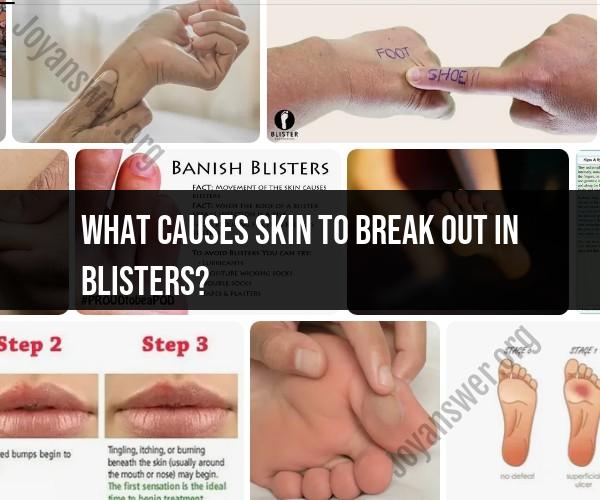What causes skin to break out in blisters?
Blisters are fluid-filled pockets that form within the layers of the skin, and they can be caused by various factors. Skin breakouts in the form of blisters are often a protective response to irritation, injury, or other skin-related issues. Here are some common causes of skin breakouts in blisters and how to prevent them:
Friction and Pressure:
- One of the most common causes of blisters is friction and pressure on the skin. This can occur from tight or ill-fitting shoes, repetitive rubbing or chafing, or the use of tools or equipment that cause constant rubbing against the skin.
Prevention: To prevent friction blisters, wear comfortable, well-fitting shoes and clothing, and use protective measures like moleskin or blister pads on areas prone to rubbing.
Burns:
- Skin can blister in response to burns, whether they are caused by hot surfaces, flames, chemicals, or excessive sun exposure (sunburn).
Prevention: Take precautions to avoid burns, such as using sunscreen, wearing protective clothing, and exercising caution around hot objects and flames.
Irritation and Allergic Reactions:
- Allergens, irritants, or harsh chemicals can cause skin reactions that lead to blister formation. This includes contact dermatitis, which occurs when the skin comes into contact with substances it's sensitive to.
Prevention: Identify and avoid triggers that cause skin irritation or allergies. If you know you have sensitivities, use hypoallergenic products and wear protective gloves when working with potential irritants.
Infections:
- Bacterial, viral, or fungal infections can cause skin lesions that may appear as blisters. Common examples include herpes simplex virus (cold sores), chickenpox, and impetigo.
Prevention: Practice good hygiene, including regular handwashing, to reduce the risk of infection. If you have a contagious infection, avoid close contact with others.
Autoimmune Conditions:
- Some autoimmune skin conditions, like pemphigus and bullous pemphigoid, can lead to blister formation. These conditions occur when the immune system mistakenly attacks the skin's own cells.
Prevention: These conditions often require medical management by a healthcare provider. Consult a dermatologist for appropriate treatment.
Medications:
- Certain medications, such as some antibiotics, can cause skin reactions and blistering as side effects in some individuals.
Prevention: If you suspect a medication is causing skin issues, consult your healthcare provider. They may adjust your medication or recommend alternative treatment options.
Insect Bites and Stings:
- Some insect bites or stings can cause localized skin reactions, including blistering.
Prevention: Take measures to avoid insect bites, such as using insect repellent and wearing protective clothing when in areas with a high risk of insect activity.
It's important to note that while blisters are a natural response to protect the skin, they should be managed properly to prevent infection. If you have recurrent or severe blistering, or if the cause is unclear, consult a healthcare provider or dermatologist for a proper diagnosis and treatment plan. Additionally, practicing good skin hygiene and taking preventive measures can help reduce the risk of skin breakouts in blisters.
Blisters and Skin Health: Unpacking the Causes of Blisters
Blisters are fluid-filled sacs that form on the skin in response to injury. They can be caused by a variety of factors, including:
- Friction: Friction is the most common cause of blisters. It occurs when the skin rubs against another surface, such as a shoe or a piece of clothing.
- Heat: Heat can also cause blisters. This can happen if you get a sunburn or if you touch something hot.
- Cold: Cold can also cause blisters. This can happen if you get frostbite or if you touch something cold for a long period of time.
- Chemicals: Some chemicals can also cause blisters. This can happen if you come into contact with a skin irritant, such as poison ivy or harsh cleaning products.
- Medical conditions: Some medical conditions can also cause blisters. This includes chickenpox, eczema, and psoriasis.
Understanding Blisters: Why Does Skin Break Out in Blisters?
When the skin is injured, the top layer of skin (epidermis) separates from the lower layer of skin (dermis). This creates a space between the two layers of skin, which fills with fluid from the dermis.
The fluid in a blister is a mixture of plasma, white blood cells, and other proteins. The plasma is the liquid portion of the blood, and it contains nutrients and antibodies that help to heal the wound. The white blood cells help to fight infection.
Blisters Demystified: Exploring the Factors Behind Skin Blisters
Here are some additional factors that can contribute to the formation of blisters:
- Moisture: Moisture can soften the skin and make it more susceptible to blisters. This is why blisters are more common in hot and humid climates.
- Pressure: Pressure can also contribute to the formation of blisters. This is why blisters are more common on areas of the body that bear a lot of weight, such as the feet.
- Illness: Some illnesses, such as diabetes and kidney disease, can also make you more susceptible to blisters.
If you develop a blister, it is important to keep it clean and protected. You can do this by applying a bandage or dressing to the blister. If the blister is large or painful, you should see a doctor.
Here are some tips to help prevent blisters:
- Wear comfortable shoes and socks. Avoid shoes that are too tight or too loose.
- Keep your skin dry. If you are sweating a lot, dry off your skin as soon as possible.
- Use protective gloves when handling chemicals.
- Be careful when exposing your skin to heat or cold.
If you are prone to blisters, there are a few things you can do to reduce your risk:
- Wear moleskin or other blister prevention tape on areas of the body that are prone to blisters.
- Use a foot powder or antiperspirant on your feet to help keep them dry.
- Take breaks from activities that cause friction, such as walking or hiking.
If you have any concerns about blisters, be sure to talk to your doctor.












